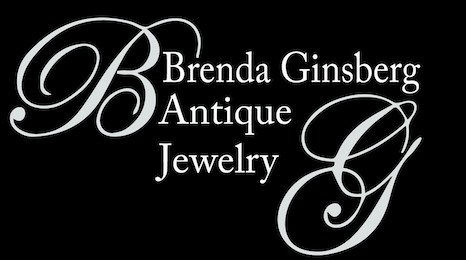Spectacular Georgian antique jewelry from Portugal.
I never gave antique Portuguese jewelry much thought until I spent 6 days in Portugal, mainly in Lisbon and nearby areas. I was knocked out by the beauty, friendliness of the people, great food and weather. Ok, the latter was a fluk. Most interesting is to delve into the history of Portugal and especially, their historic jewelry.
 #7033 Chrysoberyl and amethyst earrings.
#7033 Chrysoberyl and amethyst earrings.
The Portuguese were the first western Europeans to go a-sailing and the first to navigate all the way to India around the Cape of Good Hope (my original home town and original stomping ground). They were kings of the colonials for a while and their wealth was immeasurable at the time. Having Brazil as a colony added fabulous gemstones to their enormous resources.
When we study European antique jewelry, the 'really old' is considered pre-1800. Most jewelry we find from the 18th century hails from the Iberian Peninsula: Spain and Portugal. It is during this time (18th century), that jewelry became available to more than the highest aristocracy. It is the jewelry of the Iberian Peninsula that starts most of our hands-on studies of antique jewelry.
How can we tell the difference between the jewelry of Spain and Portugal? Usually, the only clue is the gemstone: Spanish used gems found in their colonies, like Columbia (emeralds) and the Portuguese used gems found in their overseas possessions. Topaz is one well-known example, as is rock crystal, chrysoberyl and Minas Novas, a term used for colorless topaz, very popular in the day, but supposedly, no longer found.
From the Dark and Middle Ages through Renaissance times, unmarried wealthy girls were sent to live in Convents. Widows often retired there too, so there was an enormous Convent population at the time. All of these rich ladies and their families made material contributions to the Convent, very often, in the form of jewels. Round about 1834, the King of Portugal decided, quite arbitrarily, to dissolve the Monasteries and Convents. Much of the fabulous jewelry that was stored there came onto the market. Luckily, some of it is in the National Museums of Portugal. Most of it is long sold off. Rarely, one strikes it lucky and finds a good, really old piece.
#5197 big amethyst earrings. 
Another interesting fact about Portuguese jewelry is that they used a higher standard of gold than any other Europeans. Many Europeans worked in 14k or less; the French standard is 18k, but the Portuguese use 19.25k. And, they use it to this day.
So, when you find Portuguese jewelry, on that score alone, you are getting more bang for your buck.
Having discussed the gold standard, we should remember that in fact, most diamond-looking jewelry up to the end of the 19th century was set in silver, to show off the sparkle better in candle-light. Also, because technology was not super-advanced, you may find items with gold of slightly differing standards within the very same item. A necklace built of individual gold gemset beads may be partially 18k, partially 20k and partially something else.
#5595 Portuguese ring. 
The old Portuguese jewelry is absolutely stunning. At a time when gem-cutting was relatively primitive, they put together fine, fitted gems in huge wonderful settings. Early antique Portuegese jewelry gives a whole new meaning to the word 'ingenuity'. Long, long pendeloque earrings that needed loops for ribbons to help support their weight; large rings that make a statement to this day; wonderful workmanship. Thanks to the Convents, we can enjoy these remarkable pieces over 200 years later.
In his marvellous book on Antique Paste Jewellery, M.D.S. Lewis says : Eighteenth-century Portuguese Jewellery reached a zenith of excellence and attraction. The same patterns persist, some set with coloured stones like chrysoberyls, topazes and amethysts and others with colourless crystals known in Portugal as minas-novas, but rarely if ever with paste. The stones are magnificently varied in size and shape, and this type of Jewellery is greatly prized by knowledgeable collectors.
#7273 earrings
Reference: Five Centuries of Jewellery: National Museum of Ancient Art, Lisbon. For anyone interested in the subject, this book (or even better, a visit to the museum itself) is invaluable.
See my blogs on Georgian jewelry and more to come.
 #7147 later Portuguese Art Deco snake bangle.
#7147 later Portuguese Art Deco snake bangle.
PS: Unrelated to antique jewelry, but a topic close to my heart: food. The convents were also the reason that Portugal has such delicious pastries today. You can't walk more than a block in Lisbon without encountering at least one or two enticing cake/pastry shops. In the old days, the King and his court would travel around the country and each convent would vie with the others to produce mouth-watering delicacies. This competition to please the king resulted in a vast variety of mouth-watering concoctions. mmmm!
 #5773 circa 1900 - 1910 Portuguese diamond earrings. Superb!!
#5773 circa 1900 - 1910 Portuguese diamond earrings. Superb!!
Questions and comments: Please email antiques@brendaginsberg.com
Find jewelry on www.brendaginsberg.com

